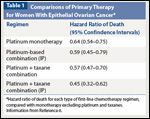Use of IP Chemotherapy in Ovarian Cancer: The Critical Questions
The article by Dr. Echarri Gonzalez and her colleagues regarding intraperitoneal (IP) chemotherapy for women with epithelial ovarian cancer provides a comprehensive yet practical review of the critical questions surrounding the use of IP chemotherapy.
The article by Dr. Echarri Gonzalez and her colleagues regarding intraperitoneal (IP) chemotherapy for women with epithelial ovarian cancer provides a comprehensive yet practical review of the critical questions surrounding the use of IP chemotherapy. As the authors note, on the basis of eight randomized, phase III trials, the US National Cancer Institute (NCI) issued a Clinical Announcement in 2006 recommending a combination of IP and intravenous (IV) chemotherapy including platins and taxanes for women with stage III ovarian cancer who have minimal residual disease after primary debulking surgery.[1] For purposes of full disclosure, all the authors of this commentary concur with the NCI Clinical Announcement.
Critical to optimal care of women with advanced ovarian cancer is the need for the combination of effective surgical debulking and chemotherapy. Primary surgery should include comprehensive surgical staging, to determine the extent of disease, as well as maximal efforts at surgical cytoreduction. The ultimate goal of surgery should be the removal of all macroscopic disease. Women left with no macroscopic disease at the close of primary surgery have significant prolongation in progression-free survival (PFS) and overall survival (OS) compared with women who have residual disease after primary surgery.[2-4]

The role of neoadjuvant chemotherapy prior to debulking surgery remains controversial. Vergote et al recently reported the results of a phase III trial, conducted by the European Organisation for Research and Treatment of Cancer Gynaecological Cancer Group (EORTC GCG) and the National Cancer Institute of Canada Clinical Trials Group (NCIC CTG), in which women with advanced ovarian cancer were randomized either to primary surgery followed by chemotherapy or neoadjuvant chemotherapy for three cycles followed by interval surgical cytoreduction.[5] For women with stage IIIC or IV ovarian cancer, survival was similar on both trial arms. The details of the actual chemotherapy are unclear. We do not know, for example, how many of the patients received taxanes in addition to platinum, or whether any of the patients received their chemotherapy via an IP route of administration. Nonetheless, on the basis of this trial, one school of investigators now routinely uses neoadjuvant chemotherapy before surgery. Another school of thought, to which we belong, prefers primary surgery. Clinicians belonging to this school generally reserve neoadjuvant chemotherapy for women deemed too sick to undergo primary surgery.

Kyrgiou et al recently conducted a meta-analysis of chemotherapy given as part of first-line treatment for advanced epithelial ovarian cancer.[6] In their review, which included 38,440 patients in 198 studies, they noted a significant decrease in the hazard ratio of death associated with the use of IP chemotherapy. As Table 1 shows, this improvement in PFS is comparable to that observed with the addition of taxanes. They concluded that the best regimen to prolong survival was a combination of a platinum and a taxane, with intraperitoneal administration. Their conclusions were consistent with those of a Cochrane Collaboration review, which found that IP chemotherapy was associated with a 20% reduction both in risk of death and recurrence.[7]
Education of Physicians and Nurses: Key to Adoption of IP Chemotherapy for Ovarian Cancer
The adoption of IP chemotherapy into standard practice for women with ovarian cancer is clearly dependent on the education of physicians and nurses. Optimal techniques for IP administration of chemotherapy include placement of the IP port, accessing the IP port, premedication, hydration, postmedication, and management of toxicities associated with both the IP port and the IP chemotherapy. After the NCI Clinical Announcement, the NCI collaborated with the international Gynecologic Cancer Intergroup to develop an educational campaign about IP chemotherapy for doctors and nurses caring for women with ovarian cancer. The US-based Gynecologic Oncology Group (GOG) and Southwest Oncology Group (SWOG), as well as the Austrian Association for Gynecologic Oncology, organized workshops on IP chemotherapy.[8,9] Review articles with detailed recommendations for the delivery of IP chemotherapy were published by Markman et al, Fujiwara et al, and Marth et al.[10-12] The GOG made available on its website videos showing placement and access of IP catheters, model patient educational material regarding IP chemotherapy, model IP chemotherapy orders, and slide presentations for healthcare professionals to learn more about IP chemotherapy.
Trials to Address Unanswered Questions
The member groups of the international Gynecologic Cancer Intergroup have also developed complementary and joint trials to address unanswered questions related to IP chemotherapy[13] (Table 2). The NCIC CTG, for example, has worked with the Spanish Ovarian Cancer Group (GEICO), Cancer Research UK, and SWOG to implement a phase III trial comparing IP/IV against IV chemotherapy after 3–4 courses of neoadjuvant chemotherapy (NCIC CTG OV21). The Japan Gynecologic Oncology Group (JGOG) and the Gynecologic Oncology Trial and Investigations Consortium (GOTIC) have undertaken a phase III trial comparing IP carboplatin versus IV carboplatin, both given with weekly dose-dense IV paclitaxel (JGOG 3019/ GOTIC-001). The US-based GOG has undertaken a phase III trial comparing two different IP regimens to IV chemotherapy, all given with bevacizumab (Avastin) during chemotherapy and as consolidation (GOG 0252). GOG 0252 also incorporates dose-dense paclitaxel in all three arms, based on the results of the JGOG study reporting a significant improvement in survival associated with dose-dense paclitaxel.[14]
The review by Echarri Gonzalez et al demonstrates that sufficient evidence is not yet available to guide clinicians through all possible clinical scenarios. Ongoing and planned trials should help to fill the gaps. However, the significant improvement in PFS and OS associated with IP chemotherapy given to women with advanced ovarian cancer does underscore a number of important issues in clinical cancer research that bear mention. First, the trials that proved the benefit of IP chemotherapy were academic, noncommercial trials, made possible both by the dedicated teams of doctors and nurses at Cooperative Group member institutions, as well as the infrastructure support provided by the US NCI and other sponsors. These trials did not involve investigational agents; thus, there was no incentive for industry to support these trials, yet important gains in survival have been demonstrated. Following publication of the results of the trials, the leadership of these groups stepped up to work with the NCI to educate their physician and nursing colleagues in North America, Asia, Europe, Australia, and elsewhere in the world about IP chemotherapy. Finally, the international Gynecologic Intergroup, a voluntary association of academic trialists, provides a valuable forum in which concepts for joint and complementary ovarian cancer trials can be discussed and successfully implemented.
Financial Disclosure: The authors have no significant financial interest or other relationship with the manufacturers of any products or providers of any service mentioned in this article.